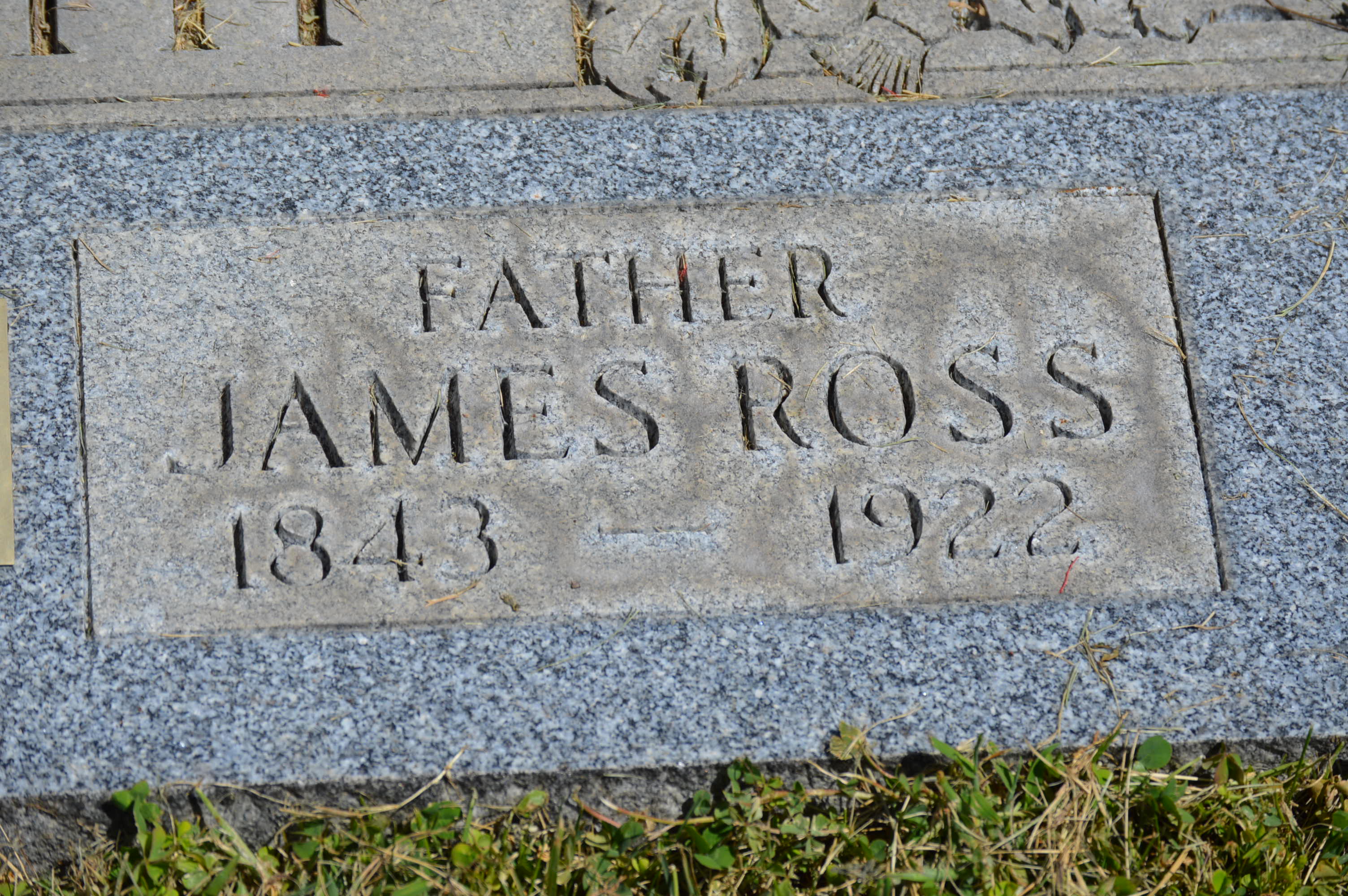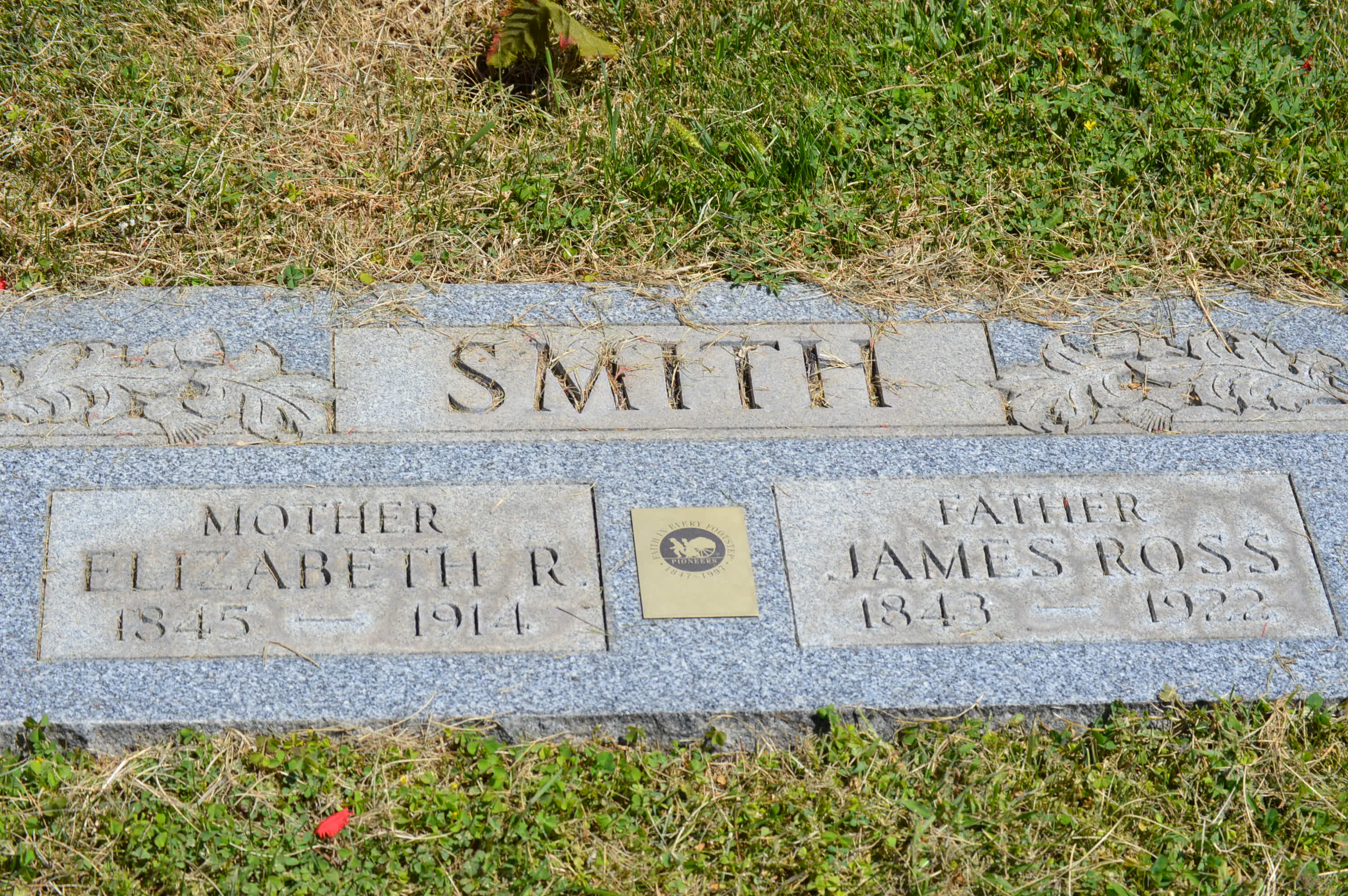1870
1880 Living in Sugar House, Salt Lake, Utah with wife, 7 children and a Hanna Bailey (unknown).
1900 District 64, Sugarhouse, Salt Lake, Utah. With wife and 10 children. He is a miller. Son John Saint is on a mission to Scotland. Son William lives with or next door.
1910 District 113, Ward 2, Salt Lake City, Utah. 250 West 8th South. With wife and 6 children. He is a flour miller.
1920 District 114, Ward 2, Salt Lake City, Utah 250 West 8th South. With daughters Elizabeth , Mary and Anna. He is widowed.
DIRECTORY
1890 Salt Lake City, Utah James R Smith City: Salt Lake State: UT Occupation: prop Year: 1890 Business Name: Queen of the Valley Roller Mill Location 2: Seventh East, 1 mile south city limits
Utah Cemetery Inventory
James Ross Smith Birth Date: 1844 Death Date: 6 Sep 1922 Death Place: Salt Lake City,Utah Burial Date: 6 September 1922 Cemetery: Salt Lake City Cemetery Source: Sexton Records Grave Location: K-1-2-1-E
Utah Death Index, 1905-1951
Name: James Ross Smith Death Date: 3 Sep 1922 State file number: 1922003600 Gender: Male Age: 78 County of Death: Salt Lake
Buried: Salt Lake City Cemetery Location: K-1-2-1-E
Emigration: on the Hudson with his Father !IMMIGRATION:John and family left London on 3 Jun 1864 aboard the Hudson and arrived in New York on 19 Jul 1864, and at Wyoming (Nebraska) August 2nd. Those family members traveling were Husband, wife, son Robert and his wife Elizabeth, son James, twins Collin and William, daughter Jane, and sons John and Charles.
William Hyde Company (1864)
Departure: 9 August 1864 Arrival in Salt Lake Valley: 26-30 October 1864 Company Information: About 350 individuals and 62 wagons were in the company when it began its journey from the outfitting post at Wyoming, Nebraska (the west bank of the Missouri River about 40 miles south of Omaha)
Company:
William Hyde Company (1864)
Narrative:
William Hyde's Church train with 62 ox-drawn wagons left Wyoming, Nebraska Territory, on August 9. Wyoming was a Missouri river port founded in 1855 and used as the principal outfitting place by Mormon companies from 1864 to 1866. It was located 44 miles south of Omaha and 6 miles north of Nebraska City. Mormons were attracted to the port city of Wyoming because of its expansive staging ground and distance from Nebraska City. It was just far enough away from the rough elements and lures of Nebraska City, yet close enough that they could easily connect with the Nebraska City-Fort Kearny Cutoff. This cutoff was established about 1860 by military freight contractors and Nebraska City businessmen. It was the shortest route from the Missouri River to Fort Kearny and became a secondary route of the Oregon Trail. It ran 169 miles directly west and shortened the distance from the old Ox-Bow Trail by about 50 miles.
Most of the 375 people in Hyde's company were Perpetual Emigrating Fund emigrants. Because of Indian troubles, Church officials instructed the party not to go beyond Salt Creek until Warren S. Snow's company caught up with them; then the two companies were to travel together. On August 30 they reached Fort Kearny, where their numbers were bolstered with others for added protection. The army reserved grazing rights at Fort Kearny, and companies weren't permitted to camp within a mile of the fort. Beyond the fort the train passed abandoned ranches and way stations and sometimes met travelers fleeing eastward. Rumors about Indians made them edgy. At one time, 500 Indians were rumored to be within a mile of the company, but no one reported actually seeing them. Although small groups of Indians did visit the train, they seemed contented with the few gifts doled out by some of the travelers. Traveling on the south side of the South Platte River, they reached Julesburg on September 12. At this place they sent a telegraph to Salt Lake reporting that many of the cattle in Hyde's and Snow's companies had a hoof ailment and requesting that 50 fresh yoke of oxen be sent to help. Within days fresh oxen and teamsters were assembled in the valley and sent east to assist them.
Julesburg was the site of a French trading post and strategically positioned at the junction point of the Upper California Crossing on the South Platte. Here they forded the South Platte and followed a new route up Lodgepole Creek. This route took them about 70 miles south of Fort Laramie through the Black Hills (present-day Laramie Mountains). They decided to take this route because feed and water were reported to be more plentiful than on the usual route via Fort Laramie. The new route took them all the way to present-day Laramie, Wyoming. Here they joined with and followed the Overland Stage Road to where it joined with the Oregon Trail near Ham's Fork. Hunters were sent out after game to augment their short rations. The company reached Ham's Fork on October 16 and arrived on a cold day in Salt Lake on October 26. Some members of the company traveled south from Echo Canyon to Heber Valley and others went down Provo Canyon. An estimated 47 people died in this late-arriving company. This was one of the largest death tolls among Mormon wagon companies.
1870
1880 Living in Sugar House, Salt Lake, Utah with wife, 7 children and a Hanna Bailey (unknown).
1900 District 64, Sugarhouse, Salt Lake, Utah. With wife and 10 children. He is a miller. Son John Saint is on a mission to Scotland. Son William lives with or next door.
1910 District 113, Ward 2, Salt Lake City, Utah. 250 West 8th South. With wife and 6 children. He is a flour miller.
1920 District 114, Ward 2, Salt Lake City, Utah 250 West 8th South. With daughters Elizabeth , Mary and Anna. He is widowed.
DIRECTORY
1890 Salt Lake City, Utah James R Smith City: Salt Lake State: UT Occupation: prop Year: 1890 Business Name: Queen of the Valley Roller Mill Location 2: Seventh East, 1 mile south city limits
Utah Cemetery Inventory
James Ross Smith Birth Date: 1844 Death Date: 6 Sep 1922 Death Place: Salt Lake City,Utah Burial Date: 6 September 1922 Cemetery: Salt Lake City Cemetery Source: Sexton Records Grave Location: K-1-2-1-E
Utah Death Index, 1905-1951
Name: James Ross Smith Death Date: 3 Sep 1922 State file number: 1922003600 Gender: Male Age: 78 County of Death: Salt Lake
Buried: Salt Lake City Cemetery Location: K-1-2-1-E
Emigration: on the Hudson with his Father !IMMIGRATION:John and family left London on 3 Jun 1864 aboard the Hudson and arrived in New York on 19 Jul 1864, and at Wyoming (Nebraska) August 2nd. Those family members traveling were Husband, wife, son Robert and his wife Elizabeth, son James, twins Collin and William, daughter Jane, and sons John and Charles.
William Hyde Company (1864)
Departure: 9 August 1864 Arrival in Salt Lake Valley: 26-30 October 1864 Company Information: About 350 individuals and 62 wagons were in the company when it began its journey from the outfitting post at Wyoming, Nebraska (the west bank of the Missouri River about 40 miles south of Omaha)
Company:
William Hyde Company (1864)
Narrative:
William Hyde's Church train with 62 ox-drawn wagons left Wyoming, Nebraska Territory, on August 9. Wyoming was a Missouri river port founded in 1855 and used as the principal outfitting place by Mormon companies from 1864 to 1866. It was located 44 miles south of Omaha and 6 miles north of Nebraska City. Mormons were attracted to the port city of Wyoming because of its expansive staging ground and distance from Nebraska City. It was just far enough away from the rough elements and lures of Nebraska City, yet close enough that they could easily connect with the Nebraska City-Fort Kearny Cutoff. This cutoff was established about 1860 by military freight contractors and Nebraska City businessmen. It was the shortest route from the Missouri River to Fort Kearny and became a secondary route of the Oregon Trail. It ran 169 miles directly west and shortened the distance from the old Ox-Bow Trail by about 50 miles.
Most of the 375 people in Hyde's company were Perpetual Emigrating Fund emigrants. Because of Indian troubles, Church officials instructed the party not to go beyond Salt Creek until Warren S. Snow's company caught up with them; then the two companies were to travel together. On August 30 they reached Fort Kearny, where their numbers were bolstered with others for added protection. The army reserved grazing rights at Fort Kearny, and companies weren't permitted to camp within a mile of the fort. Beyond the fort the train passed abandoned ranches and way stations and sometimes met travelers fleeing eastward. Rumors about Indians made them edgy. At one time, 500 Indians were rumored to be within a mile of the company, but no one reported actually seeing them. Although small groups of Indians did visit the train, they seemed contented with the few gifts doled out by some of the travelers. Traveling on the south side of the South Platte River, they reached Julesburg on September 12. At this place they sent a telegraph to Salt Lake reporting that many of the cattle in Hyde's and Snow's companies had a hoof ailment and requesting that 50 fresh yoke of oxen be sent to help. Within days fresh oxen and teamsters were assembled in the valley and sent east to assist them.
Julesburg was the site of a French trading post and strategically positioned at the junction point of the Upper California Crossing on the South Platte. Here they forded the South Platte and followed a new route up Lodgepole Creek. This route took them about 70 miles south of Fort Laramie through the Black Hills (present-day Laramie Mountains). They decided to take this route because feed and water were reported to be more plentiful than on the usual route via Fort Laramie. The new route took them all the way to present-day Laramie, Wyoming. Here they joined with and followed the Overland Stage Road to where it joined with the Oregon Trail near Ham's Fork. Hunters were sent out after game to augment their short rations. The company reached Ham's Fork on October 16 and arrived on a cold day in Salt Lake on October 26. Some members of the company traveled south from Echo Canyon to Heber Valley and others went down Provo Canyon. An estimated 47 people died in this late-arriving company. This was one of the largest death tolls among Mormon wagon companies.
Family Members
-
![]()
John Saint Smith
1869–1942
-
![]()
William Ross Smith
1870–1945
-
![]()
James Ross Smith Jr
1872–1914
-
![]()
Jeanie Ross Smith Nisbet
1874–1952
-
![]()
Ellen Ross "Nell" Smith McKendrick
1876–1967
-
![]()
Robert Ross Smith
1878–1905
-
![]()
David Ross Smith
1880–1957
-
![]()
Charles Ross Smith
1884–1884
-
![]()
Mary Campbell Smith
1885–1966
-
Joseph Jacob Smith
1887–1953
-
Sarah Janet Smith Stoffle
1891–1956
Sponsored by Ancestry
Advertisement
Advertisement




















